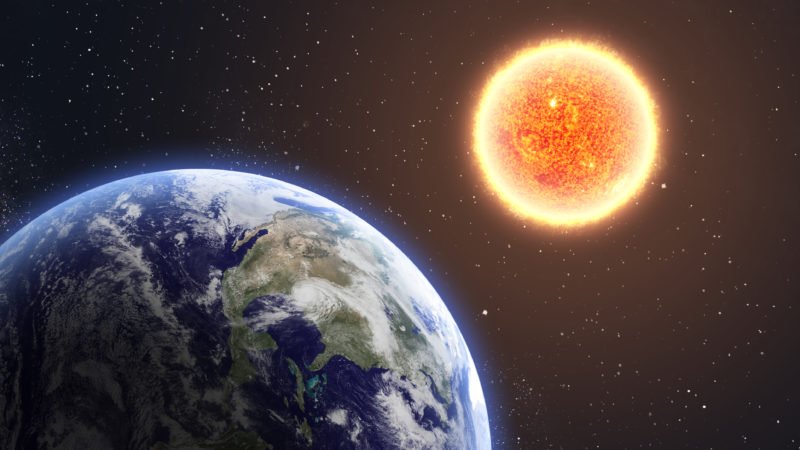
On “Perihelion Day,” our planet Earth makes its annually closest approach to the sun. The night of January 4 denotes precisely when Earth is closest to our star, yet perversely, being nearer to the sun doesn’t imply that we’ll see warmer temperatures.
Our planet Earth will arrive at its closest point to the sun for 2020 on January 4 or 5, depending on your time zone. Earth’s annual closest approach to the sun happens at precisely 7:48 Universal Time on January 5, 2020. In United States time zones, that is January 5 at 2:48 a.m. Eastern Time, 1:48 a.m. Central Time, 12:48 a.m. Mountain Time – and January 4, at 11:48 p.m. Pacific Time, 10:48 p.m. Alaskan Time and 9:48 p.m. Hawaiian Time.
Perihelion generally happens two or three weeks after the December solstice, when the Northern Hemisphere has tilted away from the sun.
The word originates from the Greek words peri (close) and helios (sun). It happens because Earth’s orbit of the sun is marginally elliptical, so there are naturally two points during a complete orbit — one year — when it’s closest and farthest away.
It’s about the tilt. Earth’s axis is tilted 23° comparative with its orbit around the sun, a phenomenon that causes the seasons. At the point when the Northern Hemisphere is tilted away from the sun, it endures winter. That tilt puts the sun lower in the Northern Hemisphere’s sky, making sunlight less intense and shortening the day. At the point when the Northern Hemisphere has tilted away from the sun, the Southern Hemisphere is tilted towards it, so it encounters summer climate during this period! It’s simply never going to be that warm north of the equator during winter.
It may appear to be logical to feel that temperatures would rise when Earth is closest to the sun. Truly, Earth is at its coolest at perihelion! That is because rocks heat up considerably more rapidly than water. The vast majority of the landmass on Earth is in the Northern Hemisphere, and the greater part of the Southern Hemisphere is the ocean. Any additional sunlight the Earth gets at perihelion is soaked by the oceans, so it doesn’t generally have a lot of impacts.
Space experts call this celebrated point in Earth’s elliptical orbit around the sun perihelion, from the Greek roots peri meaning close and helios meaning sun.
At its closest point, Earth swings to within 91,398,199 miles (147,091,144 km) of the sun. That is rather than a half year from now when the Earth arrives at aphelion – its most distant point – on July 4, 2020. At that point, we’ll be 94,507,635 miles (152,095,295 km) from the sun.
In other words, Earth is around 3 million miles (5 million km) closer to the sun toward the beginning of January than it is toward the beginning of July. That is consistently the situation. Earth is closest to the sun every year toward the beginning of January when it’s winter for the Northern Hemisphere.
So you see there’s not a gigantic distance difference between perihelion and aphelion. Earth’s orbit is very nearly circular. Hence it’s not our distance from the sun – but rather the tilt of our world’s axis – that makes winter and summer on Earth.
It’s the definite inverse to perihelion. It denotes the day when Earth is farthest from the sun, which is consistently on or near July 4, around about fourteen days after the June solstice. At that most distant point, Earth will be 94,507,635 miles from the sun. In any case, even though the sun is a little weaker, the rocky Northern Hemisphere warms up easily, so you can anticipate sweltering temperatures (even though we’re farther from the sun).
The Earth is closest to the Sun, or at the perihelion, around about fourteen days after the December Solstice, when it is winter in the Northern Hemisphere. Then again, the Earth is farthest from the Sun, at the aphelion point, 2 weeks after the June Solstice, when the Northern Hemisphere is enjoying warm summer months.
Google's NotebookLM app now offers Audio Overviews, an AI tool that transforms your research into… Read More
Google Wallet is adding a new method to verify your age while protecting your identity,… Read More
PayPal has expanded its advertising capabilities beyond its own platform with the launch of Offsite… Read More
Google recently revealed that it will host a separate event to discuss upcoming Android improvements… Read More
In today’s competitive work environment, mentorship has become more than a professional courtesy—it’s a strategic… Read More
Choosing the right programming language is a foundational step in shaping a developer's career and… Read More